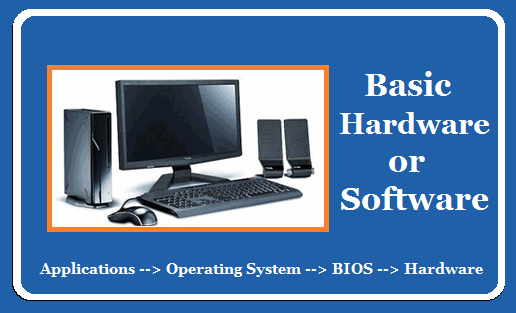Basic Hardware or Software Components of Network:

Network interfaces Controller (NIC):
NIC is a hardware accessory that provides a computer with both a physical interface for accepting a network cable connector and the ability to process low-level network information.
In Ethernet networks, each network interface controller has a unique Media Access Control address which is usually stored in the card’s permanent memory. MAC address uniqueness is maintained and administered by the Institute of Electrical and Electronics Engineers (IEEE) in order to avoid address conflicts between devices on a network.
The size of an Ethernet MAC address is six octets. The 3 most significant octets are reserved to identify card manufacturers. The card manufacturers, using only their assigned prefixes, uniquely assign the 3 least-significant octets of every Ethernet card they produce.
Repeaters:
A repeater is an electronic device that receives a network signal, cleans it of unnecessary noise, and regenerates it. The signal is re-transmitted at a higher power level, or to the other side of an obstruction so that the signal can cover longer distances without degradation.
In most twisted pair Ethernet configurations, repeaters are required for the cable that runs longer than 100 meters. A repeater with multiple ports is known as a hub. Repeaters work on the physical layer of the OS I model. Repeaters require a small amount of time to regenerate the signal.
This can cause a propagation delay which can affect network performance. As a result, many network architectures limit the number of repeaters that can be used in a row.
Bridges:
A network bridge connects multiple network segments at the data link layer of the OSI model to form a single network. Bridges broadcast to all ports except the port on which the broadcast was received.
However, bridges do not promiscuously copy traffic to all ports, as hubs do. Instead, bridges learn which MAC addresses are reachable through specific ports. Once the bridge associates a port with an address, it will send traffic for that address to that port only.
Bridges learn the association of ports and addresses by examining the source address of frames that it sees on various ports. Once a frame arrives through a port, the bridge assumes that the MAC address is associated with that port and stores its source address.
The first time a bridge sees a previously unknown destination address, the bridge will forward the frame to all ports other than the one on which the frame arrived.
Switches:
A network switch is a device that forwards and filters OSI layer 2 datagrams between ports based on the MAC addresses in the packets. A switch is distinct from a hub in that it only forwards the frames to the ports involved in the communication rather than all ports connected.
A switch breaks the collision domain but represents itself as a broadcast domain. Switches make decisions about where to forward frames based on MAC addresses. A switch normally has numerous ports, facilitating a star topology for devices, and cascading additional switches.
The term switch is often used loosely to include devices such as routers and bridges, as well as devices that may distribute traffic based on load or based on application content.
Router:
A router is an internetworking device that forwards packets between networks by processing the routing information included in the packet or datagram.
The routing information is often processed in conjunction with the routing table. A router uses its routing table to determine where to forward packets.
Local Operating System:
A local operating system allows personal computers to access files, print to a local printer, and have and use one or more disk and CD drives that are located on the computer. Examples are MS-DOS, Unix, Linux, Windows 2000, Windows 98, Windows XP etc.
Network Operating System:
The network operating system is a program that runs on computers and servers and allows the computers to communicate over the network.
Servers:
Servers are computers that hold shared files, programs, and the network operating system. Servers provide access to network resources to all the users of the network.
There are many different kinds of servers, and one server can provide several functions. For example, there are file servers, print servers, mail servers, communication servers, database servers, fax servers and web servers, to name a few.






![[Top 10] Best ways to Earn Money Online 2023 popular ways to earn online money](https://bytizenotes.com/wp-content/uploads/2023/02/make-money-online-100x70.png)
Very informative and helpful article. Thanks for giving me an opportunity to read this valuable article.